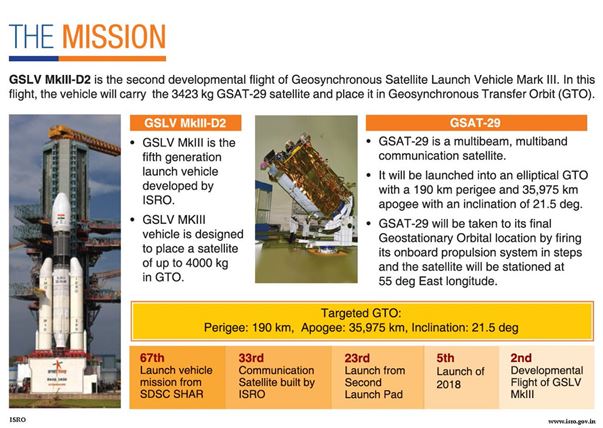ForumIAS announcing GS Foundation Program for UPSC CSE 2025-26 from 19 April. Click Here for more information.
ForumIAS Answer Writing Focus Group (AWFG) for Mains 2024 commencing from 24th June 2024. The Entrance Test for the program will be held on 28th April 2024 at 9 AM. To know more about the program visit: https://forumias.com/blog/awfg2024
Another orbit: on GSAT29 launch
News:
- The Indian Space Research Organisation recently successfully launched its latest communication satellite GSAT-29, which was put in its orbit by India’s heavy-lift rocket Geosynchronous Satellite Launch Vehicle (GSLV-Mk III).
Important Facts:
- About GSLV MkIII: With a liftoff mass of 640 tonnes, the GSLV MkIII is the heaviest launch vehicle made in India, and GSAT29 is the heaviest satellite to take off from Indian soil.
- The launcher GSLV Mk III, can carry payloads up to 4 tonnes to the geosynchronous transfer orbit and up to 10 tonnes to a low-earth orbit.
- The launch was a key test to the GSLV Mk III as it carried the GSAT-29 weighing 3,423 kg and placed it into a geosynchronous transfer orbit where the satellite’s closest approach to earth would be 190 km and the farthest 35,975 km.
- Along for the ride were also a few additional payloads — an experimental Q and V band communication satellite, a device for optical communication and a high-resolution camera as part of a demonstration for use in future ISRO space missions.
- The first operational mission of this vehicle (GSLV-MkIII) is going to be the Chandrayaan-II mission in January, 2019.
- Earlier launches:
- The first successful experimental flight of the GSLV MkIII was in 2014 when it carried a dummy crew module as a payload. This proved its capacity in the atmospheric flight regime.
- Its first developmental flight was in 2017, when it launched GSAT19, weighing 3,136 kg.
- The present launch marked the second developmental flight of the MkIII.
- With these two successes, the launcher is declared ‘operational’ and joins the ranks of the working vehicles, the PSLV and the GSLV.
- However, this is far fewer than the number of developmental flights the older launch vehicles were subjected to. This is because the solid and liquid propellant stages had been tested before. The third cryogenic stage could establish its performance in just two developmental flights.
- Significance: The success sets the stage for trying out variations such as other types of engines, different fuel combinations and higher launch capacity.
- The GSLV MkIII has not just boosted the satellite into its orbit, but also restored morale at ISRO, which had been dented by the GSAT 6A setback.
- About GSAT-29:
- The satellite, called GSAT-29, is a communications satellite with two separate payloads designed to improve telecommunication and internet services under the ‘Digital India’ program.
- The communication satellite, “is a multiband, multi-beam communication satellite, intended to serve as test bed for new and critical technologies,” according to ISRO.
- The Ku-band and Ka-band payloads are expected to cater to communication requirements for people in remote areas in the country, especially Jammu and Kashmir, and the North-East.





